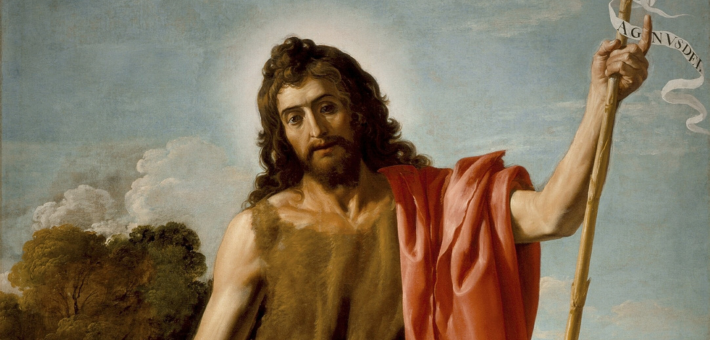Commentary on John 1:6-8, 19-28
The other day, as I was sitting down in a coffee shop meditating on this passage, I couldn’t help but overhear two older gentlemen at the table next to me arguing about who is the greatest baseball player in history. It was a relatively well-mannered debate that was fun for both fine gentlemen. I’ll spare you the specifics of their argument so as not to send the baseball fans among the readers on a mental tangent, but suffice it to say that they were making grandiose claims about their chosen players. The superlatives were flying, and each statement was grander than the last.
While I’m sure they believed everything they were saying and that there were factual foundations to their arguments, it was the hyperbole of their presentation that really made a difference in their arguments, both for one another and for those of us, due to the volume of their conversation, who had no choice but to listen.
As I read again John’s description of the one coming after him, I felt the power of his hyperbole in making his argument. By describing himself as someone unworthy of untying the straps of Jesus’ sandals, he is declaring himself to be the unworthiest of all to amplify the worthiness of Jesus. His hyperbole serves a few different functions in this text, like how those two gentlemen were talking about baseball, and preachers would find fruitful ground in playing with the ways that hyperbole might work as we describe both our unworthiness and Jesus’ worshipful status.
Beyond merely emphasizing the worth of Jesus, this exaggerated speech helps build excitement about the reveal of Jesus, helps build community around the “legend” of this yet-unknown figure, and might serve as the kind of persuasion necessary to get someone to pay attention to the gospel being preached, for surely the “worthiest of all time” is worth learning more about.
Knowing who you aren’t
Before the line about worthiness, John has a back-and-forth with the priests and Levites about his identity. Verse 20 says that “he confessed and did not deny it,” in reference to his continued “nos” to their questions. After asking whether he was the Messiah, Elijah, or the prophet, the priests and Levites finally ask John an open-ended question and allow him to tell them his identity. But before getting to John’s quotation of Isaiah in verse 23, it is important to underline John’s confession of who he isn’t.
The text emphasizes his confession of not being the Messiah. And unlike the hyperbolic sandal statement that was previously discussed, this honest confession of who he was not is necessary at a time when there is confusion about John’s role. The double confession plus the negative made it abundantly clear that he was the witness pointing back toward the light, and not the light himself.
This negative confession serves as an important reminder for proclaimers and doers of the word. Our sermons should point back toward the light and avoid being so heavily associated with the preacher that the primary star is miscast. Similarly, the actions that we take in the community for the cause of the gospel must also point back toward the light, lest our churches become more noteworthy than the Jesus we profess to profess. One of my dear friends always prays to “make Jesus famous,” and I was reminded of that when reading John’s navigation of these rapid-fire questions from the priests and the Levites.
Light and dark
John’s mission and identity are further clarified in the earlier passage from our lection. In the midst of the poetic start to this chapter, there is a pause on the cosmic description of Jesus for a short description of John’s role as witness to it all. John is said to have been sent as a witness to testify to the light, with the goal of everyone believing in the light. While the light mentioned here is a clear reference to Jesus, more specifically this light is the life of all people. One might think of it as life force, the animating power of our lives, and the darkness cannot extinguish this light. John is a witness to this light, to life, to Jesus the Christ who came to give us life, and life more abundantly.
If we are to pick up John’s mantle and proclaim light and life in our congregations, we must celebrate the inextinguishable light available to us. Advent must elicit excitement for a light that can’t go out. Like the burning bush that was on fire but did not burn, Jesus is the light that the darkness of death cannot extinguish. And this is good news! In a world that is increasingly dark, amplifying the persistence and tenacity of the light in our sermons will be a welcome bit of hope to all.
A word about recognition
This passage is full of what seems somewhat comedic, at least from the perspective of John and the readers—banter back and forth between John and the priests. But there at the end, in addition to the sandal hyperbole, John lets them know that Jesus is already there among them. They had a recognition problem; they were oblivious to the presence of the light that was immediately in their midst. This passage may also call forth sermons that talk about what it means for us to be attentive to the light, and how we might avoid the problem of recognition found with the priests and Levites. Was it a problem of openness? Perhaps of faulty expectations? Was it too dark for them to see the light? Or could there have been a perception problem? There is a lot of room here to explore as we think about the challenges our congregations face in recognizing the light.


December 17, 2023